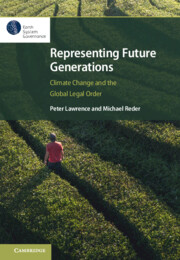Refine search
Actions for selected content:
653 results
Political representation from the people’s perspective: the problem-solving principal–agent partnership
-
- Journal:
- European Journal of Political Research ,
- Published online by Cambridge University Press:
- 01 October 2025, pp. 1-21
-
- Article
-
- You have access
- Open access
- HTML
- Export citation
Representation matters: Technocracy, populism, and attitudes towards international organisations
-
- Journal:
- European Journal of Political Research ,
- Published online by Cambridge University Press:
- 30 September 2025, pp. 1-19
-
- Article
-
- You have access
- Open access
- HTML
- Export citation
Chosen (not) to win? Party nomination strategies and the unequal class representation in parliament
-
- Journal:
- European Journal of Political Research ,
- Published online by Cambridge University Press:
- 30 September 2025, pp. 1-21
-
- Article
-
- You have access
- Open access
- HTML
- Export citation
4 - Re-presenting Rights
-
-
- Book:
- Reckoning with Law in Excess
- Published online:
- 09 September 2025
- Print publication:
- 25 September 2025, pp 96-119
-
- Chapter
-
- You have access
- Open access
- HTML
- Export citation

Representing Future Generations
- Climate Change and the Global Legal Order
-
- Published online:
- 19 September 2025
- Print publication:
- 09 October 2025
-
- Book
-
- You have access
- Export citation
Chapter 10 - Revival in the West
- from Part III - Mythologies of the Literary Revival
-
-
- Book:
- The Revival in Irish Literature and Culture
- Published online:
- 04 September 2025
- Print publication:
- 18 September 2025, pp 203-221
-
- Chapter
- Export citation
Chapter 11 - Synge, Modernity, and the Myth of Revival
- from Part III - Mythologies of the Literary Revival
-
-
- Book:
- The Revival in Irish Literature and Culture
- Published online:
- 04 September 2025
- Print publication:
- 18 September 2025, pp 222-238
-
- Chapter
- Export citation
It Takes a Village: The Representative Role of Members of Parliament Staff
-
- Journal:
- Canadian Journal of Political Science/Revue canadienne de science politique , First View
- Published online by Cambridge University Press:
- 04 September 2025, pp. 1-23
-
- Article
-
- You have access
- Open access
- HTML
- Export citation
Chapter 4 - The Face of a Genius
-
- Book:
- Face and Form
- Published online:
- 21 August 2025
- Print publication:
- 04 September 2025, pp 83-101
-
- Chapter
-
- You have access
- Open access
- HTML
- Export citation
Public demand and LGBTQ+ rights
-
- Journal:
- Journal of Public Policy , First View
- Published online by Cambridge University Press:
- 29 August 2025, pp. 1-23
-
- Article
-
- You have access
- Open access
- HTML
- Export citation
Mapping representation before the International Tribunal for the Law of the Sea
-
- Journal:
- Leiden Journal of International Law , First View
- Published online by Cambridge University Press:
- 26 August 2025, pp. 1-22
-
- Article
-
- You have access
- Open access
- HTML
- Export citation
Dilemmas in Representation: Immigration, Identity, and Political Parties
-
- Journal:
- Journal of Race, Ethnicity and Politics , First View
- Published online by Cambridge University Press:
- 19 August 2025, pp. 1-21
-
- Article
-
- You have access
- HTML
- Export citation
Chapter 6 - Truth and Truthfulness
- from Part II - Virtues of Direct Caring
-
- Book:
- Attention to Virtues
- Published online:
- 25 July 2025
- Print publication:
- 14 August 2025, pp 120-140
-
- Chapter
- Export citation
1 - Medieval States and Estates
- from Part I - State-Building and Political Participation
-
- Book:
- Democracy's Double Helix
- Published online:
- 09 September 2025
- Print publication:
- 14 August 2025, pp 31-55
-
- Chapter
- Export citation
The Rise of Women Vice-Presidential Candidates in Latin America – Corrigendum
-
- Journal:
- Politics & Gender , First View
- Published online by Cambridge University Press:
- 11 August 2025, p. 1
-
- Article
-
- You have access
- HTML
- Export citation
5 - Legal Concepts as a Deep Structure of the Law
- from Part II - Reinach and Private Law Theory
-
-
- Book:
- Reinach and the Foundations of Private Law
- Published online:
- 20 July 2025
- Print publication:
- 07 August 2025, pp 125-149
-
- Chapter
-
- You have access
- Open access
- HTML
- Export citation
7 - Global Statistical Analyses
-
- Book:
- States against Nations
- Published online:
- 14 August 2025
- Print publication:
- 07 August 2025, pp 185-200
-
- Chapter
-
- You have access
- Export citation
Chapter 8 - Learning in visual arts
- from Part 2 - What: the arts learning areas
-
- Book:
- Teaching the Arts
- Published online:
- 28 July 2025
- Print publication:
- 06 August 2025, pp 235-278
-
- Chapter
- Export citation
2 - Pagan Iconography
- from Part I - Architecture and Iconography
-
- Book:
- The Cambridge Encyclopaedia of Late Antique Art and Archaeology
- Published online:
- 04 July 2025
- Print publication:
- 31 July 2025, pp 28-42
-
- Chapter
- Export citation
22 - Toward a More Just International Law
- from Part VI - Criticism and Reconstruction of the Legitimacy of International Law
-
- Book:
- The Law and Politics of International Legitimacy
- Published online:
- 14 July 2025
- Print publication:
- 24 July 2025, pp 413-461
-
- Chapter
- Export citation
